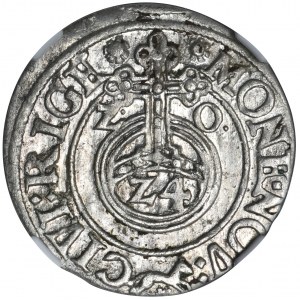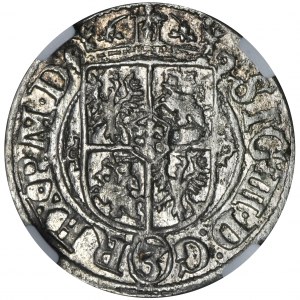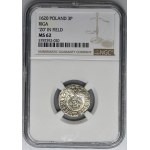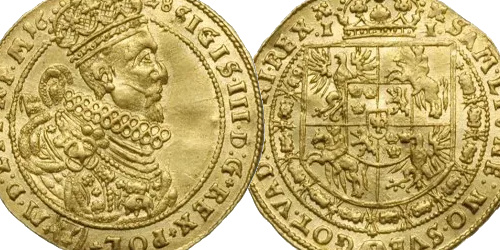Rarer 1620 Lynx half-track, with a fox at the bottom of the rim.
A beautiful, select piece.
Issuance of half-tracks began in 1614 for trade with Brandenburg and later with Silesia. The drawing of the reverse with a characteristic apple resembled German pennies (apfelgroschen). The denomination appeared on the coin in two places. The number "24" placed in the apple meant that the half-taler was 1/24th of a thaler (in fact, its value was lower). In turn, the number "3" at the bottom of the obverse meant that the coin was worth 3 halfpence. Crown half-pennys were minted at the Bydgoszcz mint and at another mint (varieties with crossed hooks). The literature mentions the Wschowa mint, the Cracow mint, possibly the second production line of the Bydgoszcz mint. Lithuanian half-tracks were issued by the Vilnius mint, while municipal ones were issued by the Riga mint. During the reign of Sigismund III, half-tracks were minted on the basis of three mint ordinances: 1614 (trial VII ½ a flotation; pure silver content - 0.739 g), 1619 (VI ½ a flotation; 0.5 g), 1623 (VI a flotation; 0.45 g).
The background of the monetary history of the Commonwealth during the reign of Sigismund Vasa was the progressive monetary crisis caused by the situation in Germany and the influx of the spodleniated German coinage into Poland. Initially, the mint rate was determined by Stefan Batory's ordinance of 1580. With the crisis deepening, in 1601 it was decided to raise the mint rate, i.e. devalue the denominations in circulation. The following years saw further legislation lowering the silver content of various denominations. Of these, the most important was the Ordinance of 1623. It introduced a stable monetary system, based on the monetary system of the Empire. During the reign of Sigismund III, new denominations appeared in the Polish-Lithuanian Commonwealth - three-cornered coins, halves and orts. In turn, in 1621, the highest denomination in the history of Polish money was minted at the Bydgoszcz mint - the hundred-drachma. This was the crowning achievement of the intensive issuance of gold coins during the reign of Sigismund III. Crown mints (Olkusz, Wschowa, Poznań, Malbork, Bydgoszcz, Lublin, Kraków, Warsaw), Lithuanian mints (Vilnius), municipal mints (Gdańsk, Elbląg, Toruń, Riga, Poznań, Wschowa) and a private mint in Łobżenica worked during this period. Sigismund Vasa's Swedish coins were issued by mints in Stockholm, Rewal and Malbork. In 1627, a decision was made to stop issuing small coinage. This decision remained in force until 1650.










